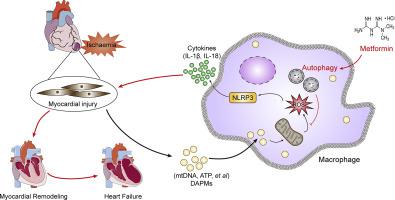Journal of Molecular and Cellular Cardiology ( IF 4.9 ) Pub Date : 2020-05-26 , DOI: 10.1016/j.yjmcc.2020.05.016 Qin Fei 1 , Heng Ma 1 , Jiang Zou 1 , Wenmei Wang 1 , Lili Zhu 1 , Huafei Deng 1 , Meng Meng 1 , Sipin Tan 1 , Huali Zhang 1 , Xianzhong Xiao 1 , Nian Wang 2 , Kangkai Wang 1

|
Myocardial ischaemia is usually accompanied by inflammatory response which plays a critical role in the myocardial healing and scar formation, while persistent inflammatory response contributes greatly to the myocardial remodeling and consequent heart failure. Metformin (Met), a widely used hypoglycemic drug, has increasingly been shown to exert remarkable cardioprotective effect on ischaemic myocardial injury such as acute myocardial infarction (AMI). However, the underlying mechanisms are still far from being fully understood. In this study, a mouse model of AMI was established through ligating the left anterior descending coronary artery (LAD), 100 mg/kg Met was given immediately after operation once daily for 3 days. It was demonstrated that Met effectively improved the cardiac haemodynamics (LVSP, LVEDP, +dp/dt, −dp/dt), diminished the infarct size, alleviated the disarrangement of myocardial cells and reduced the infiltration of inflammatory cells (macrophages, neutrophils and lymphocytes) in the heart of AMI mice. Mechanistically, Met decreased the expression of NLRP3 and enhanced the accumulation of LC3 puncta in F4/80-positive macrophages in the heart of AMI mice. Single cell suspension of cardiac macrophages was prepared from AMI mice and exhibited increased NLRP3 mRNA and protein expression. In contrast, Met decreased the expression of NLRP3 and p62, whereas increased the ratio of LC3II/LC3I. Additionally, both conditioned medium from H9c2 cardiomyocytes exposed to hydrogen peroxide (H9c2-H2O2-CM) and combination of mtDNA and ATP (mtDNA-ATP) increased the expression of NLRP3 and cleaved caspase-1 (p10) as well as intracellular ROS production in RAW264.7 macrophages, which were abrogated by Met treatment. Strikingly, chloroquine (CQ), 3-methyladenine (3-MA) and knockdown of autophagy-related gene (Atg5) abrogated the inhibitory effects of Met on H9c2-H2O2-CM and mtDNA-ATP-induced NLRP3 expression, release of IL-1β and IL-18 as well as ROS production in RAW264.7 macrophages. Collectively, these findings suggest that Met protects against ischaemic myocardial injury through alleviating autophagy-ROS-NLRP3 axis-mediated inflammatory response in macrophages.
中文翻译:

二甲双胍通过减轻巨噬细胞中自噬-ROS-NLRP3 介导的炎症反应来防止缺血性心肌损伤。
心肌缺血通常伴随炎症反应,炎症反应在心肌愈合和瘢痕形成中起关键作用,而持续的炎症反应对心肌重构和随之而来的心力衰竭有很大贡献。二甲双胍(Met)是一种广泛使用的降血糖药物,越来越多地被证明对急性心肌梗死(AMI)等缺血性心肌损伤具有显着的心脏保护作用。然而,其潜在机制仍远未完全了解。本研究通过结扎左冠状动脉前降支(LAD)建立AMI小鼠模型,术后立即给予100mg/kg Met,每日1次,连续3天。结果表明,Met 能有效改善心脏血流动力学(LVSP、LVEDP、+dp/dt、-dp/dt),减少了梗死面积,减轻了心肌细胞的紊乱,并减少了 AMI 小鼠心脏中炎症细胞(巨噬细胞、中性粒细胞和淋巴细胞)的浸润。从机制上讲,Met 降低了 NLRP3 的表达并增强了 AMI 小鼠心脏 F4/80 阳性巨噬细胞中 LC3 斑点的积累。从 AMI 小鼠制备心脏巨噬细胞的单细胞悬浮液,并表现出增加的 NLRP3 mRNA 和蛋白质表达。相比之下,Met 降低了 NLRP3 和 p62 的表达,而增加了 LC3II/LC3I 的比率。此外,来自 H9c2 心肌细胞的两种条件培养基都暴露于过氧化氢(H9c2-H AMI 小鼠心脏中的中性粒细胞和淋巴细胞)。从机制上讲,Met 降低了 NLRP3 的表达并增强了 AMI 小鼠心脏 F4/80 阳性巨噬细胞中 LC3 斑点的积累。从 AMI 小鼠制备心脏巨噬细胞的单细胞悬浮液,并表现出增加的 NLRP3 mRNA 和蛋白质表达。相比之下,Met 降低了 NLRP3 和 p62 的表达,而增加了 LC3II/LC3I 的比率。此外,来自 H9c2 心肌细胞的两种条件培养基都暴露于过氧化氢(H9c2-H AMI 小鼠心脏中的中性粒细胞和淋巴细胞)。从机制上讲,Met 降低了 NLRP3 的表达并增强了 AMI 小鼠心脏 F4/80 阳性巨噬细胞中 LC3 斑点的积累。从 AMI 小鼠制备心脏巨噬细胞的单细胞悬浮液,并表现出增加的 NLRP3 mRNA 和蛋白质表达。相比之下,Met 降低了 NLRP3 和 p62 的表达,而增加了 LC3II/LC3I 的比率。此外,来自 H9c2 心肌细胞的两种条件培养基都暴露于过氧化氢(H9c2-H Met 降低了 NLRP3 和 p62 的表达,而增加了 LC3II/LC3I 的比率。此外,来自 H9c2 心肌细胞的两种条件培养基都暴露于过氧化氢(H9c2-H Met 降低了 NLRP3 和 p62 的表达,而增加了 LC3II/LC3I 的比率。此外,来自 H9c2 心肌细胞的两种条件培养基都暴露于过氧化氢(H9c2-H2 O 2 -CM) 以及 mtDNA 和 ATP 的组合 (mtDNA-ATP) 增加了 RAW264.7 巨噬细胞中 NLRP3 和裂解的 caspase-1 (p10) 的表达以及细胞内 ROS 的产生,这些都被 Met 处理消除了。引人注目的是,氯喹 (CQ)、3-甲基腺嘌呤 (3-MA) 和自噬相关基因 (Atg5) 的敲低消除了 Met 对 H9c2-H 2 O 2 -CM 和 mtDNA-ATP 诱导的 NLRP3 表达、释放的抑制作用IL-1β 和 IL-18 以及 RAW264.7 巨噬细胞中 ROS 的产生。总的来说,这些发现表明 Met 通过减轻巨噬细胞中自噬-ROS-NLRP3 轴介导的炎症反应来防止缺血性心肌损伤。











































 京公网安备 11010802027423号
京公网安备 11010802027423号